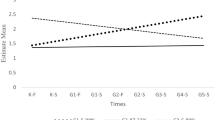Abstract
The behavioral problems of Chinese children were examined in a questionnaire study of a representative sample of 3,069 seven-year-old Chinese schoolboys in Hong Kong using Rutter's questionnaires for completion by parents and teachers. Separate robust dimensions of hyperactivity, antisocial, and neurotic behaviors were evident. The correlations among different dimensions were similar to those reported in the West. Short-term longitudinal analysis suggested that these dimensions were stable over time and that antisocial behaviors might develop in hyperactive children. The finding highlights the necessity of differentiating the hyperactive domain from the antisocial one. A significant source effect was found in all three dimensions. Chinese schoolboys had nearly two times the level of questionnaire-rated hyperactivity compared with school boys in the West; but it is premature to conclude that hyperactivity is more common in Chinese schoolboys in Hong Kong. Cross-cultural differences in adults' expectations and tolerance remain a plausible explanation.
Similar content being viewed by others
References
Achenbach, T. M., Bird, H. R., Canino, G., Phares, V., Gould, M. S., & Rubio-Stipec, M. (1990). Epidemiological comparisons of Puerto Rican and U.S. mainland children: Parent, teacher, and self-reports.Journal of the American Academy of Child and Adolescent Psychiatry, 29, 84–93.
Achenbach, T. M., & Edelbrock, E. S. (1978). The classification of child psychopathology: A review and analysis of empirical efforts.Psychological Bulletin, 85, 1275–1301.
Achenbach, T. M., Hensley, V. R., Phares, V., & Grayson, D. (1990). Problems and competencies reported by parents of Australian and American children.Journal of Child Psychology and Psychiatry, 31, 265–286.
Conners, C. K. (1969). A teacher rating scale for use in drug studies with children.American Journal of Psychiatry, 126, 884–888.
Ekblad, S. (1990). The children's behaviour questionnaire for completion by parents and teachers in a Chinese sample.Journal of Child Psychology and Psychiatry, 31, 775–791.
Fergusson, D. M., & Horwood, L. J. (1993). The structure, stability and correlations of the trait components of conduct disorder, attention deficit and anxiety/withdrawal reports.Journal of Child Psychology and Psychiatry, 34, 749–766.
Fergusson, D. M., Horwood, L. J., & Lloyd, M. (1991). Confirmatory factor models of attention deficit and conduct disorder.Journal of Child Psychology and Psychiatry, 32, 257–274.
Hinshaw, S. (1987). On the distinction between attentional deficits/hyperactivity and conduct problems/aggression in child psychopathology.Psychological Bulletin, 101 443–463.
Luk, S. L., Leung, P. W. L., & Lee, P. L. M. (1988). Conners' teacher rating scale in Chinese children in Hong Kong.Journal of Child Psychology and Psychiatry, 29, 165–174.
Luk, S. L., Lieh-Mak, F., Leung, P. W. L., Ho, T. P., Taylor, E., & Bacon-Shone, J. (1993).A Hong Kong-United Kingdom cross-cultural study of childhood hyperactivity: A research report to Croucher Foundation. Department of Psychiatry, University of Hong Kong.
Matsuura, M., Okubo, Y., Kojima, T., Takahashi, R., Wang, Y. F., Shen, Y. C., & Lee, C. K. (1993). A cross national prevalence study of children with emotional and behavioral problems—A WHO collaborative study in the Western Pacific region.Journal of Child Psychology and Psychiatry, 34, 307–316.
McGee, R., Silva, P. A., & Williams, S. (1984). Behavior problems in a population of seven-year-old children: Prevalence, stability and types of disorder—A research report.Journal of Child Psychology and Psychiatry, 25, 251–259.
McGee, R., Williams, S., Bradshaw, J., Chapel, J. L., Robins, A., & Silva, P.A. (1985). The Rutter scale for completion by teachers: Factor structure and relationships with cognitive abilities and family adversity for a sample of New Zealand children.Journal of Child Psychology and Psychiatry, 26, 727–739.
Morita, H., Suzuki, M., & Kamoshita, S. (1990). Screening measures for detecting psychiatric disorders in Japanese secondary school children.Journal of Child Psychology and Psychiatry, 31, 603–617.
Quay, H. (1986). Classification. In H. Quay & J. Werry (Eds.),Psychopathological disorders in childhood (pp. 1–34). John Wiley & Sons.
Rutter, M. (1967). A children's behavior questionnaire for completion by teachers: Preliminary findings.Journal of Child Psychology and Psychiatry, 8, 1–11.
Rutter, M., Tizard, J., & Whitmore, K. (1970).Education, health and behaviour. London: Longman.
Rutter, M., Yule, W., Berger, M., Yule, B., Morton, J., & Bagley, C. (1974). Children of West Indian immigrants—I. Rates of behavioral deviance and of psychiatric disorder.Journal of Child Psychology and Psychiatry, 15, 241–262.
Sandberg, S. T., Rutter, M., & Taylor, E. (1978). Hyperkinetic disorder in psychiatric clinic attenders.Developmental Medicine and Child Neurology, 20, 279–299.
Schachar, R., Rutter, M., & Smith, A. (1981). The characteristics of situationally and pervasively hyperactive children: Implications for syndrome definition.Journal of Child Psychology and Psychiatry, 22, 375–392.
Taylor, E., & Sandberg, S. (1984). Hyperactive behavior in English schoolchildren: A questionnaire survey.Journal of Abnormal Child Psychology, 12, 143–156.
Taylor, E., Sandberg, S., Thorley, G., & Giles, S. (1991).The epidemiology of childhood hyperactivity (Institute of Psychiatry Maudsley Monograph). London: Oxford University Press.
Taylor, E., Schachar, R., Thorley, G., & Weiselberg, M. (1986). Conduct disorder and hyperactivity: I. Separation of hyperactivity and antisocial conduct in British child psychiatric patients.British Journal of Psychiatry, 149, 760–767.
Wang, Y. F., Shen, Y. C., Gu, B. M., Jia, M. X., & Zhang, A. L. (1989). An epidemiological study of behaviour problems in school children in urban areas of Beijing.Journal of Child Psychology and Psychiatry, 30, 907–912.
Weisz, J. R., Suwanlert, S., Chaiyasit, W., Weiss, B., Achenbach, T. M., & Walter, B. R. (1987). Epidemiology of behavioral and emotional problems among Thai and American children: Parents reports for ages 6–11.Journal of American Academy of Child and Adolescent Psychiatry, 26, 890–897.
Zimmermann-Tansella, C., Minghetti, S., Tacconi, A., & Tansella, M. (1978). The children's behavior questionnaire by teachers in an Italian sample: Preliminary results.Journal of Child Psychology and Psychiatry, 19, 167–173.
Author information
Authors and Affiliations
Additional information
This study was supported by the Croucher Foundation. We would like to thank the Education Department of Hong Kong for assistance in sampling. We are particularly grateful to the children, teachers, and parents who participated in this study.
Rights and permissions
About this article
Cite this article
Ho, T.P., Leung, P.W.L., Luk, E.S.L. et al. Establishing the constructs of childhood behavioral disturbances in a Chinese population: A questionnaire study. J Abnorm Child Psychol 24, 417–431 (1996). https://doi.org/10.1007/BF01441565
Received:
Issue Date:
DOI: https://doi.org/10.1007/BF01441565



